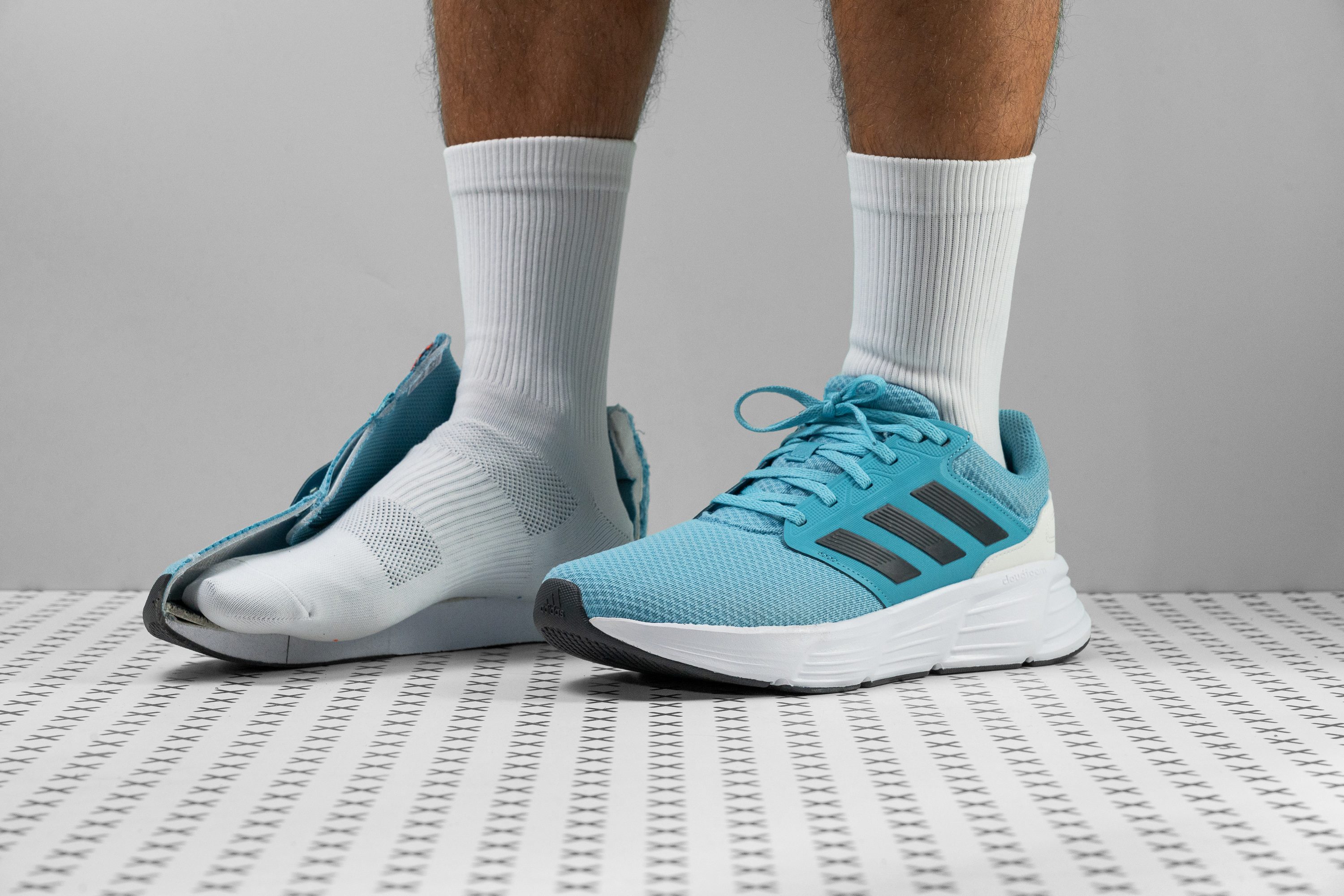Our verdict
Pros
- Ideal for wide feet
- Well-padded midsole
- Comfortable upper material
- Suitable for winter runs
- Stable
- Great for beginners
- Ideal for easy runs
- Excellent value
Cons
- Subpar breathability
- Excessively heavy
- Poor traction
Audience verdict
Comparison
The most similar running shoes compared
+ + Add a shoe | |||||
|---|---|---|---|---|---|
| Audience score | 82 Good! | 84 Good! | 85 Good! | 82 Good! | |
| Price | £45 | £70 | £155 | £80 | |
| Pace | Daily running | Daily running | Daily running | Daily running | |
| Shock absorption | Moderate | - | Moderate | Low | |
| Energy return | Low | - | Moderate | Low | |
| Traction | Low | - | Moderate | Low | |
| Arch support | Neutral | Neutral | Neutral | Neutral | |
| Weight lab Weight brand | 11.7 oz / 332g 11.6 oz / 330g | 11.2 oz / 318g 10.1 oz / 285g | 11.1 oz / 316g 11.1 oz / 316g | 11.5 oz / 326g 12.1 oz / 343g | |
| Drop lab Drop brand | 11.0 mm 10.0 mm | 12.9 mm 8.0 mm | 9.8 mm 9.0 mm | 11.3 mm 9.0 mm | |
| Strike pattern | Heel | Heel | HeelMid/forefoot | Heel | |
| Size | True to size | True to size | Half size small | True to size | |
| Midsole softness | Balanced | Balanced | Soft | Balanced | |
| Difference in midsole softness in cold | Normal | Normal | Big | Normal | |
| Toebox durability | Bad | Bad | Good | Decent | |
| Heel padding durability | Bad | Bad | Decent | Decent | |
| Outsole durability | Decent | Decent | Good | Decent | |
| Breathability | Warm | Moderate | Moderate | Breathable | |
| Width / fit | Wide | Medium | Medium | Medium | |
| Toebox width | Wide | Medium | Medium | Medium | |
| Stiffness | Stiff | Moderate | Moderate | Moderate | |
| Torsional rigidity | Stiff | Moderate | Moderate | Moderate | |
| Heel counter stiffness | Flexible | Flexible | Flexible | Flexible | |
| Heel lab Heel brand | 33.9 mm | 31.9 mm 34.0 mm | 34.2 mm 39.0 mm | 30.3 mm 25.0 mm | |
| Forefoot lab Forefoot brand | 22.9 mm | 19.0 mm 26.0 mm | 24.4 mm 30.0 mm | 19.0 mm 16.0 mm | |
| Widths available | Normal | NormalWide | NormalWideX-Wide | NormalWide | |
| Orthotic friendly | ✓ | ✓ | ✓ | ✓ | |
| Season | All seasons | All seasons | All seasons | SummerAll seasons | |
| Removable insole | ✓ | ✓ | ✓ | ✓ | |
| Ranking | #296 Bottom 21% | #244 Bottom 35% | #202 Bottom 46% | #289 Bottom 23% | |
| Popularity | #291 Bottom 23% | #322 Bottom 15% | #197 Bottom 47% | #181 Top 48% |
Who should buy
The Adidas Galaxy 6 stands out in its own unique way. At only £60, we think it's a fantastic pick for budget-conscious runners who crave a well-cushioned and stable shoe. With more than 30 mm of foam in the heel, it offers the softest ride we've seen in a budget-friendly Adidas shoe. Oh, and in our experience, it's also a great choice for those runners with wide feet.
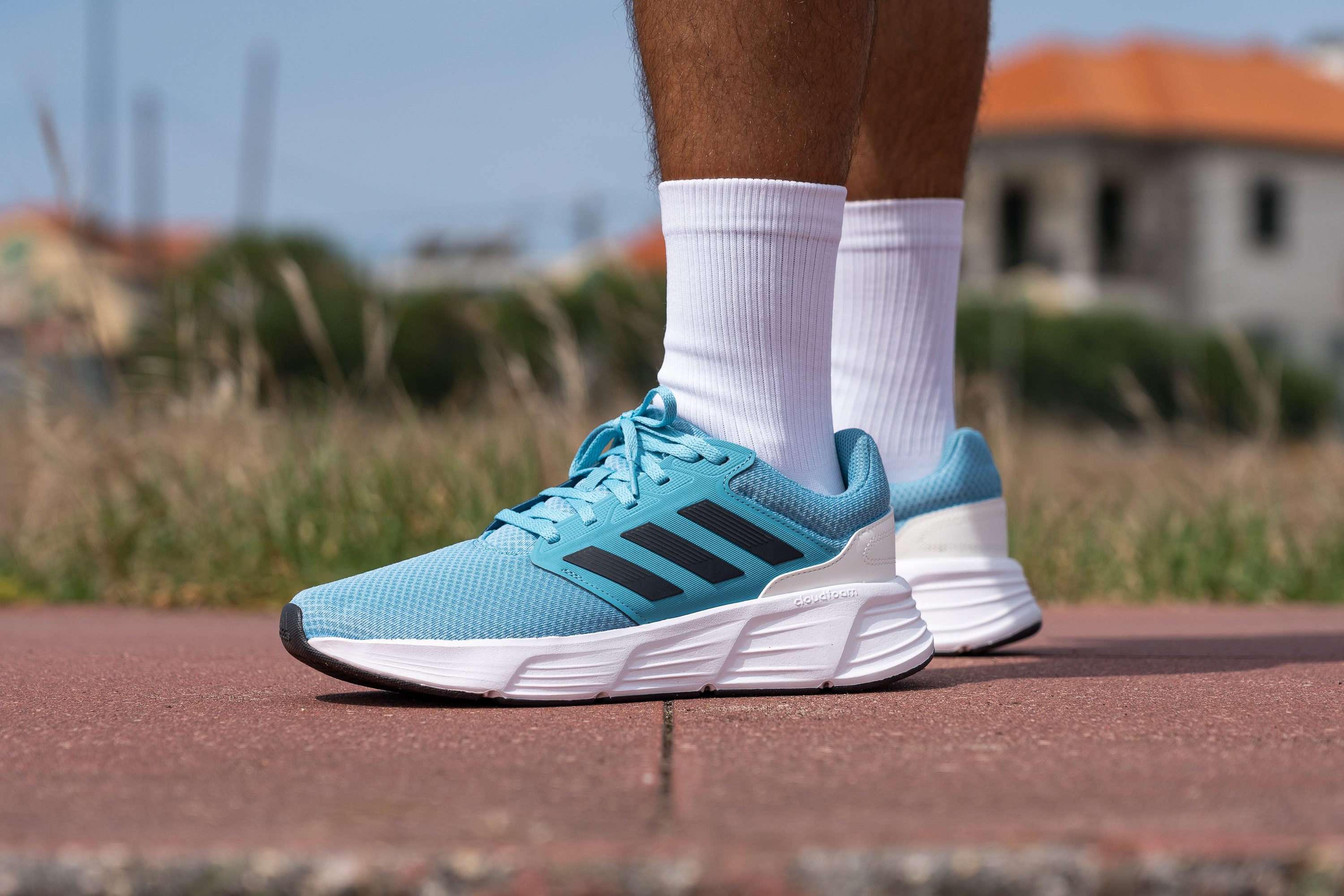
Who should NOT buy
If heavy shoes aren't your thing, you definitely want to avoid the Galaxy 6. It's not just heavy—it can feel like you're dragging your feet when you attempt to pick up the pace. From our tests, the Runfalcon 3 could be a better, lighter and still budget-friendly choice from the Adidas lineup.
Runners living in warmer climates might also want to pass on the Galaxy 6. Its breathability is one of the poorest we've tested, and there are certainly better options available for a similar price point. The Saucony Axon 2, for instance, is a much more breathable alternative.
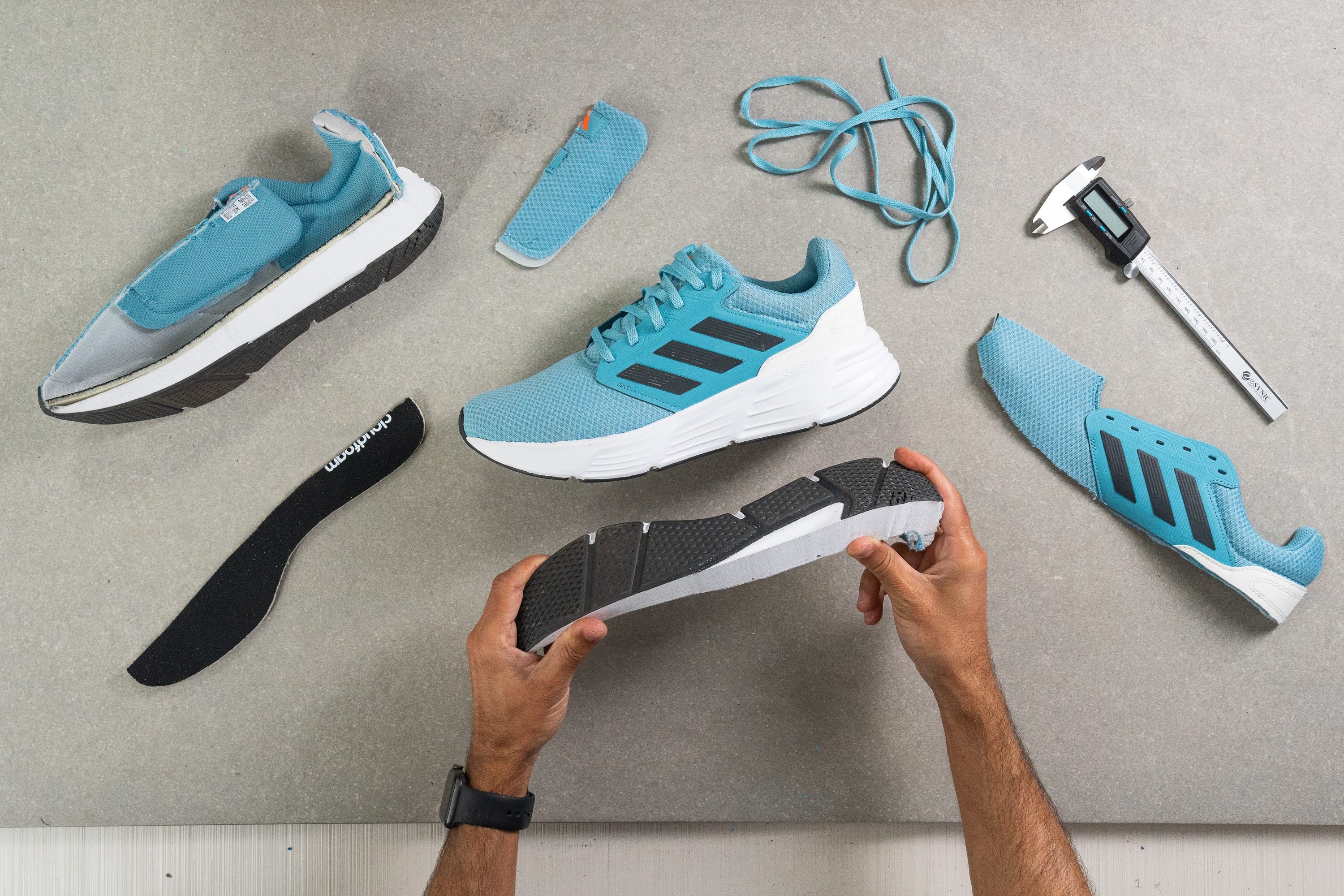
Cushioning
Shock absorption
We tested the Galaxy 6 using the ASTM F1976 standard and found its shock absorption surprisingly low, with just 111 SA in the heel.
For short runs or quick-paced efforts, we think it gets the job done—but heavier runners aiming for longer distances might find its protection lacking.
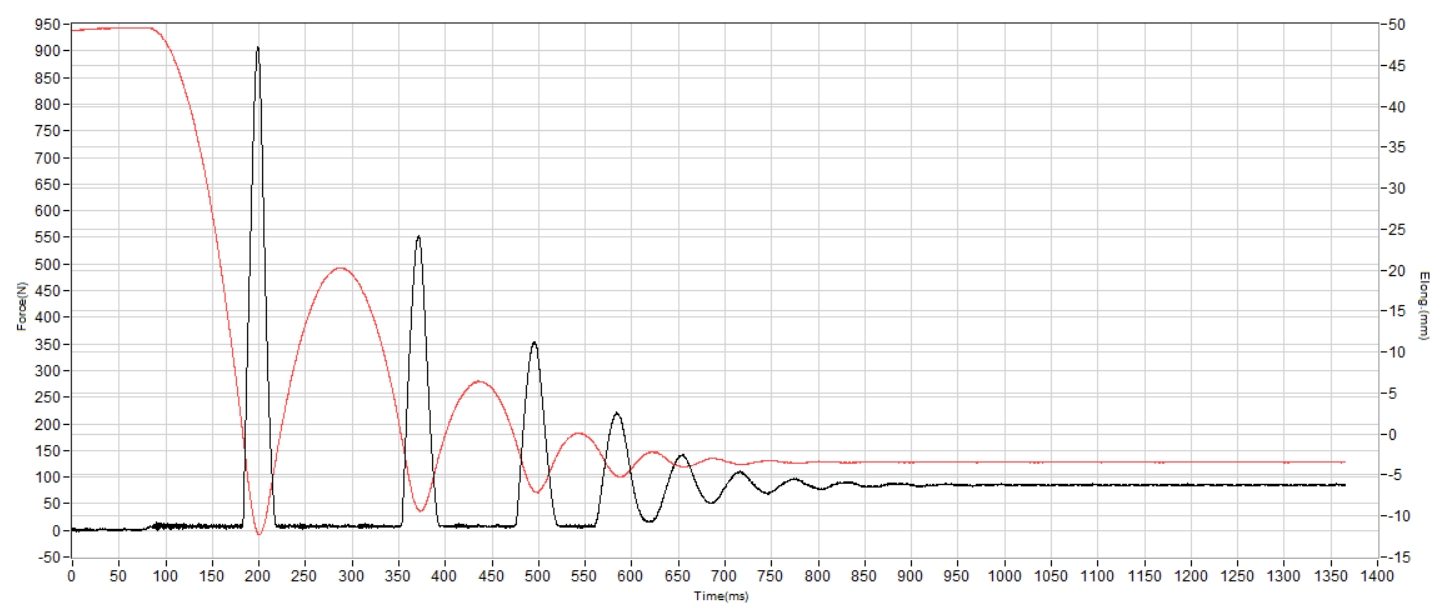
| Galaxy 6 | 111 SA |
| Average | 129 SA |
Energy return
The heel delivers 52% energy return, which falls below the average for road running shoes. Still, expecting anything above 60% in an entry-level model would be unrealistic, and surpassing the 50% mark at this ultra-low price point is already a solid achievement.
| Galaxy 6 | 51.9% |
| Average | 58.5% |
Heel stack
A significant factor contributing to the weight of this shoe is its high heel stack height. Although, at 33.9 mm, it's seen as pretty standard in today's running shoe world. But it packs a Cloudfoam EVA midsole that is far from being light.

| Galaxy 6 | 33.9 mm |
| Average | 34.8 mm |
Forefoot stack
The forefoot of the shoe is slightly thinner than we would prefer, measuring only 22.9 mm.
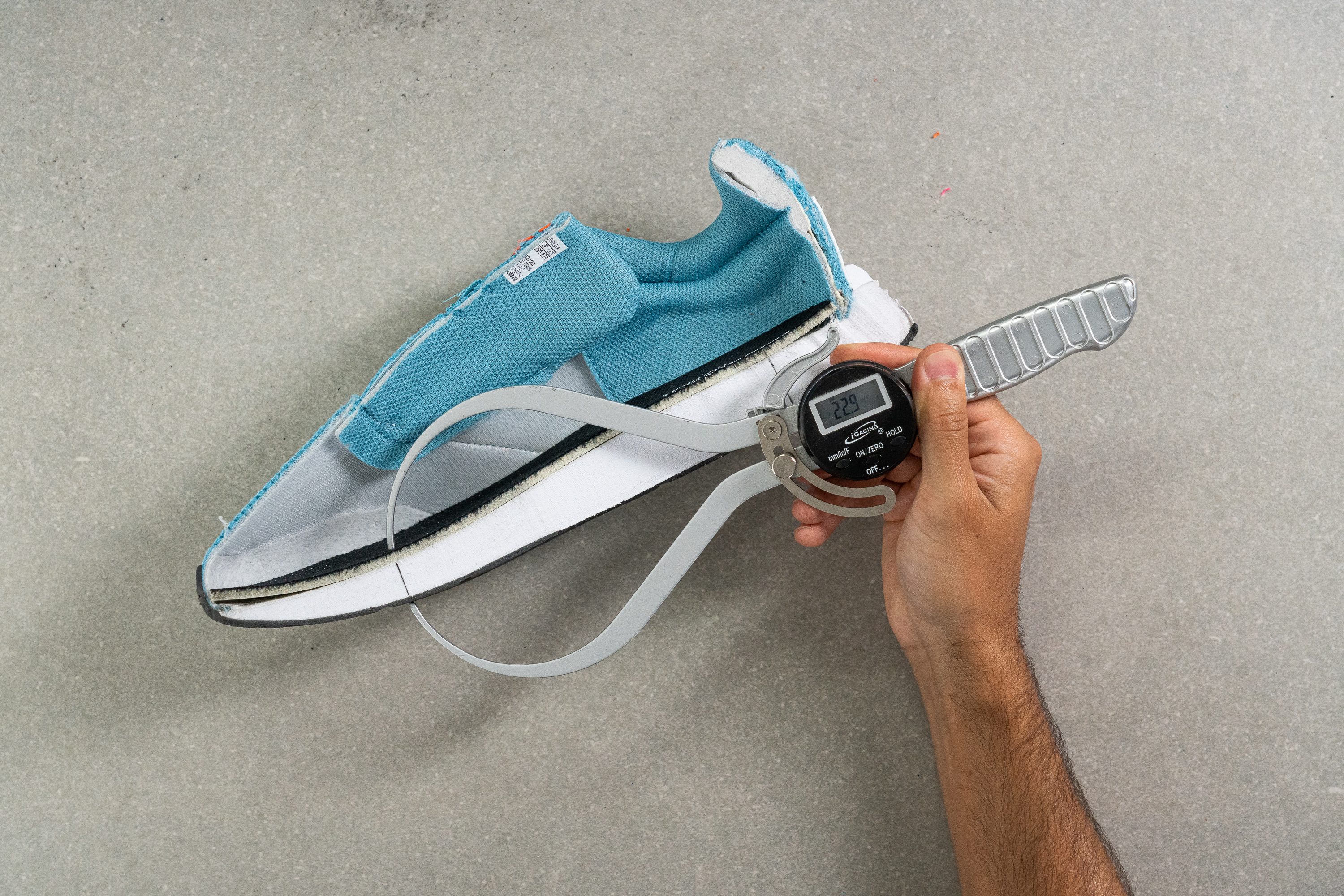
| Galaxy 6 | 22.9 mm |
| Average | 26.2 mm |
Drop
This shoe presents an 11-mm heel-to-toe drop, a characteristic quite typical for Adidas training shoes that usually surpass the 10-mm mark.
Considering this feature, it's evident that this shoe is designed for beginners and heel strikers.
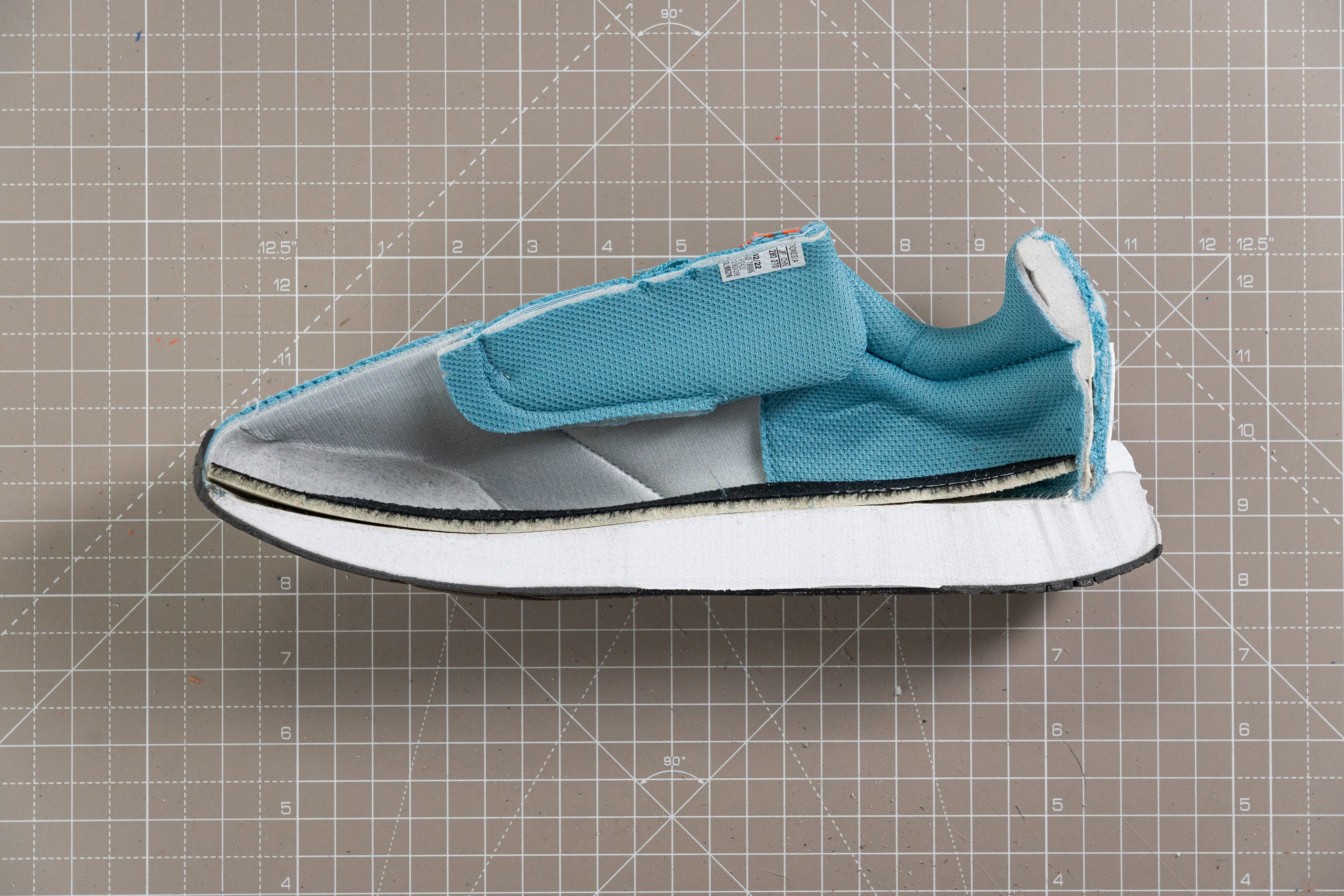
| Galaxy 6 | 11.0 mm |
| Average | 8.6 mm |
Midsole softness
With a softness rating of 22.9 HA, the Cloudfoam midsole is surprisingly cushy for a £60 shoe, which typically offers a firmer ride.
Adidas has been criticised in the past for the firmness of their midsoles in shoes like Lightstrike or other Cloudfoam models. Now, it seems they are fine-tuning this compound to truly deliver a cloud-like feel that lives up to the name.

| Galaxy 6 | 22.9 HA |
| Average | 20.4 HA |
Size and fit
Size
Adidas Galaxy 6 fits true to size (33 votes).
Width / Fit
We measured the widest part of the upper, registering a comfortable 107.2 mm. This clearly signifies that the shoe is an excellent choice for runners with wider feet.
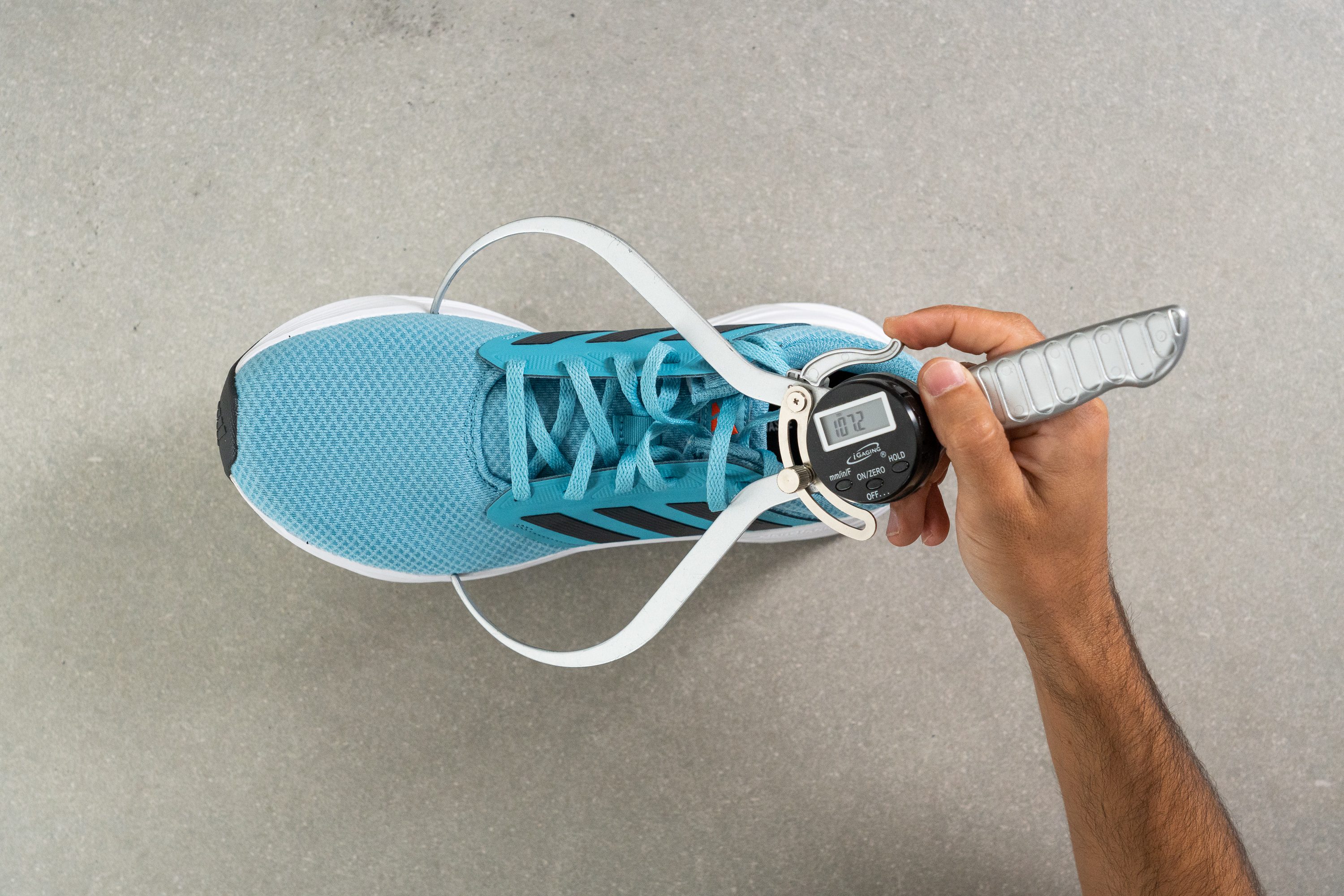
This test follows an older methodology, which is why you don't see recently tested shoes in the chart. Results from different methodologies can not be compared.
| Galaxy 6 | 107.2 mm |
| Average | 98.5 mm |
Toebox width
Measuring in at 81.8 mm, the space surrounding the big toe provides ample room. This allows almost any feet the freedom to move and expand, especially during those warm summer runs.
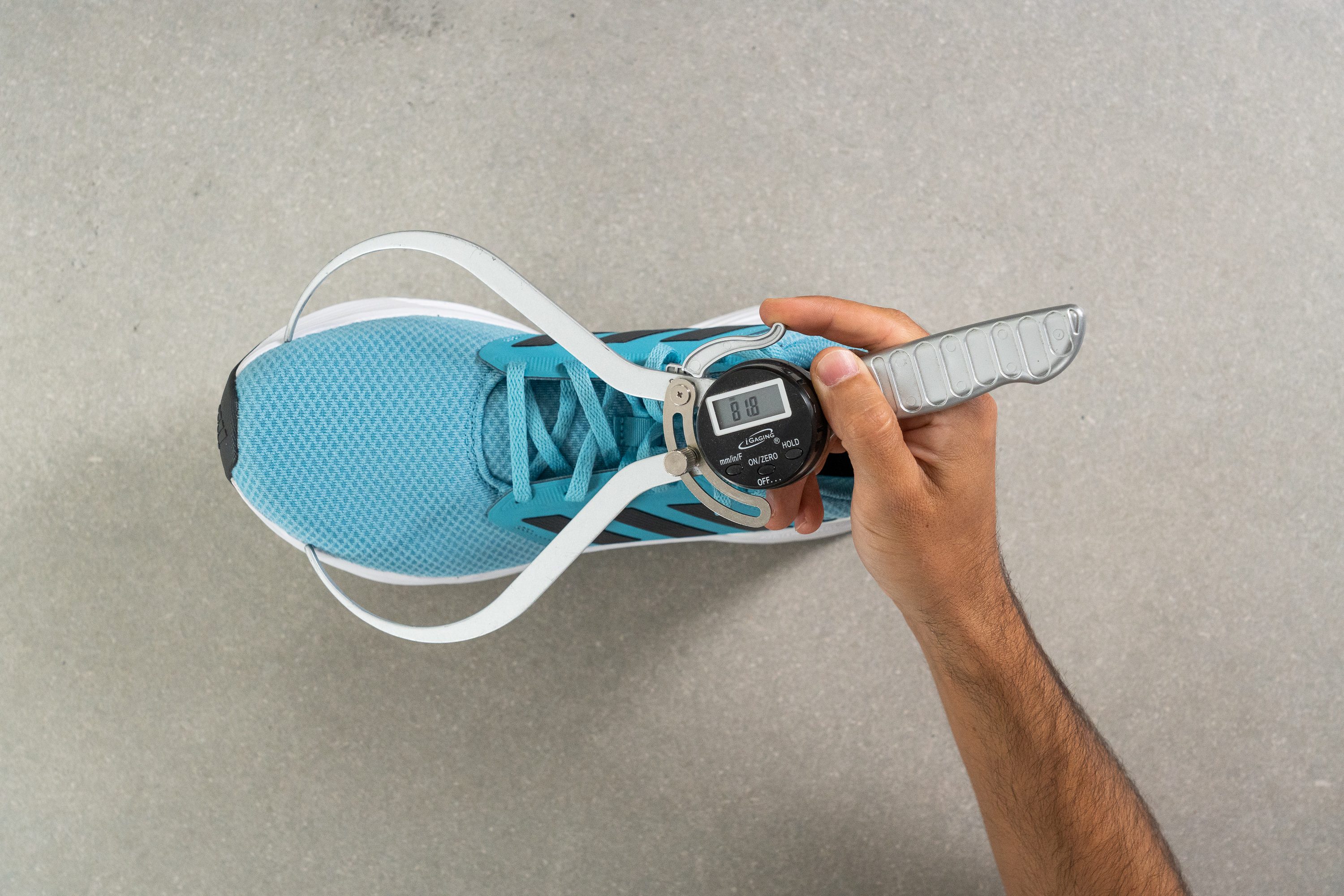
This test follows an older methodology, which is why you don't see recently tested shoes in the chart. Results from different methodologies can not be compared.
| Galaxy 6 | 81.8 mm |
| Average | 78.4 mm |
Traction / Grip
Traction test
One of the weakest points of the Adidas Galaxy 6 is its grip. We measured a worryingly low 0.24 score, confirming that it struggles on wet pavement and feels below average on dry ground compared to nearly every other shoe.
| Galaxy 6 | 0.24 |
| Average | 0.48 |
Outsole design
The outsole of the Adidas Galaxy 6 uses a full-length rubber layout with a classic segmented design. Coverage is generous and aims for durability across all contact points. However, despite the solid-looking pattern, our lab testing showed subpar grip, and this makes it less dependable than other budget-friendly models if you're running on slick surfaces.

Flexibility / Stiffness
When we conducted our 30-degree bend test, it reached 17.6N—putting it among the stiffer daily trainers we've tested. This rigidity won't please fans of highly-flexible shoes and makes it a less appealing choice for everyday use.
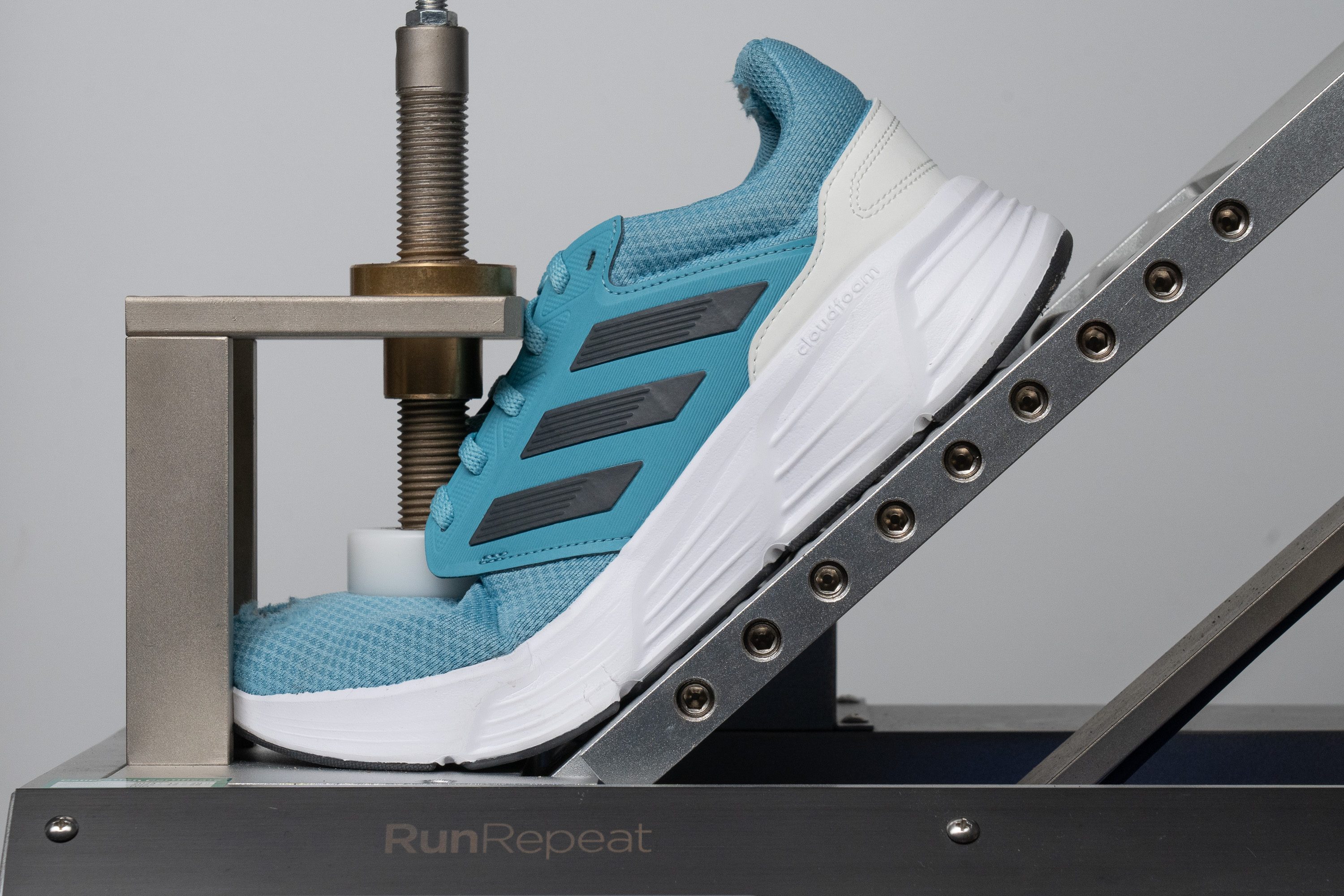
| Galaxy 6 | 17.6N |
| Average | 15.3N |
Stiffness in cold (%)
However, the story changes when we put the Galaxy 6 through the same test after 20 minutes in the freezer. The shoe became significantly stiffer in the cold, with a measurement of 36.8N in the same bend test.
This increase of 71.3% is a significant shift and rather disappointing even for a low-priced shoe.
| Galaxy 6 | 71% |
| Average | 33% |
Weight
What we love of lab testing shoes is that you can't sugarcoat the numbers. This shoe is undeniably heavy.
Weighing in at 11.7 oz (332g) for a US size 9, it isn't a deal-breaker, but we'd be happier if it could get closer to the 10 oz benchmark. Maybe in v7?
| Galaxy 6 | 11.7 oz (332g) |
| Average | 9.3 oz (264g) |
Breathability
If you're dreaming of running through any galaxy with these, you'd better aim with your spaceship for one that's consistently cool. Our state-of-the-art breathability test revealed disappointing airflow. So disappointing, in fact, we only gave it a 2/5 rating.
This score is low, even for a £60 shoe like this one. The budget-friendly price might explain some shortcomings, but we were hoping for at least average performance in this area.
When we shone a light through the upper, it barely let any light through. This explains the mediocre airflow.
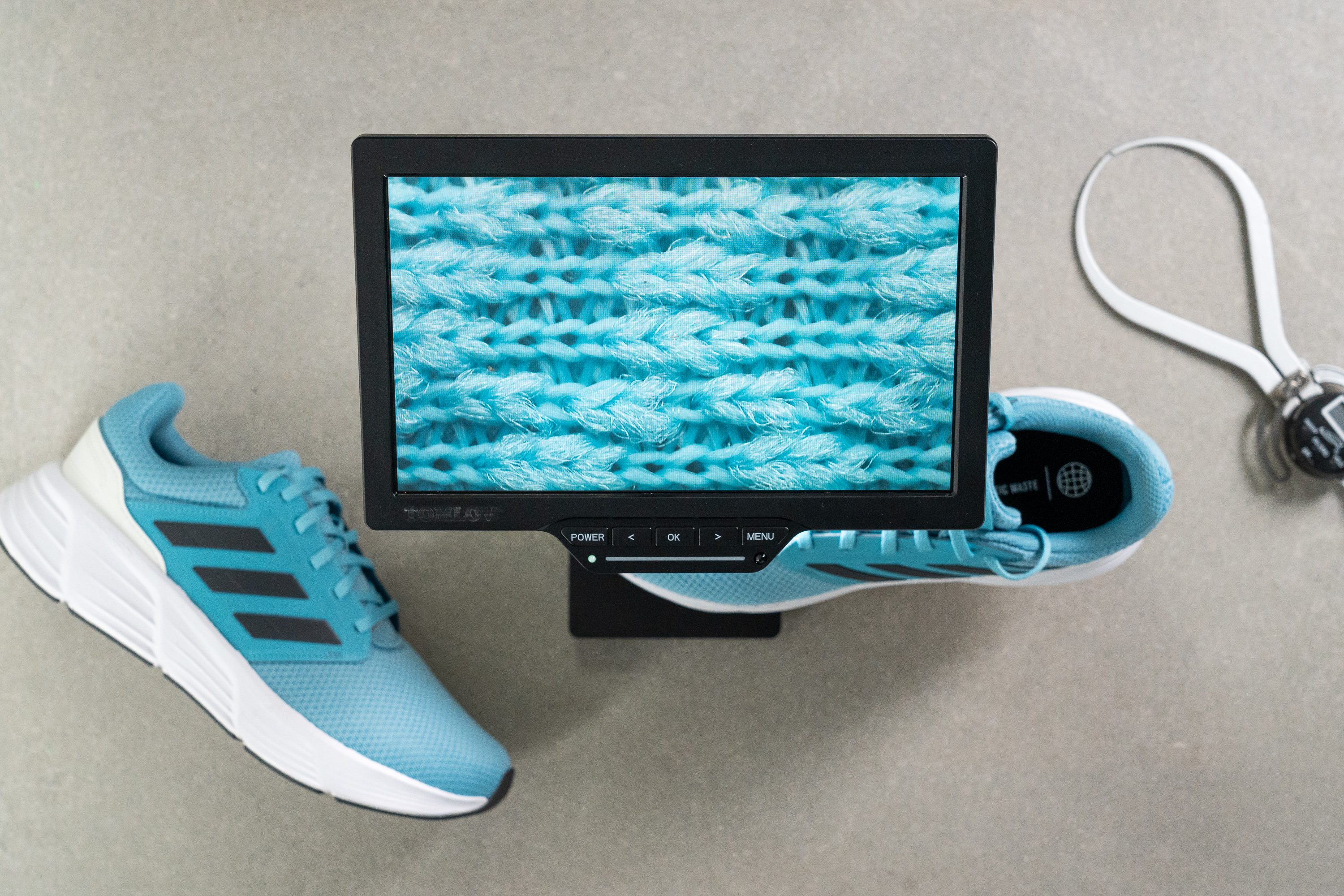
But it's under our microscope that the full picture emerges. Adidas opted for a design that includes a thick, dense engineered mesh, effectively destroying the shoe's ventilation.

On a brighter note, it's important to acknowledge that the poor airflow does bring unparalleled comfort. The Galaxy 6 is not just any ordinary shoe—it's one of the most exceedingly comfortable shoes that we've ever had the pleasure to analyse in the lab. It's padded everywhere!
| Galaxy 6 | 2 |
| Average | 3.7 |
Stability
Lateral stability test
If you're on the hunt for an affordable shoe that offers excellent stability, your search is over. The Galaxy 6 remains steady and stable.
Torsional rigidity
A key reason for the excellent stability of the Galaxy 6 is its torsional rigidity. We gave it a 4 out of 5 rating, a score that aligns well with other stability-focused shoes and surpasses the average shoe.
However, there's a trade-off. The shoe may not be as comfortable as you would want for everyday wear.
| Galaxy 6 | 4 |
| Average | 3.5 |
Heel counter stiffness
The heel counter of the Galaxy 6 is notably flexible, earning a rating of just 1 out of 5 from us.
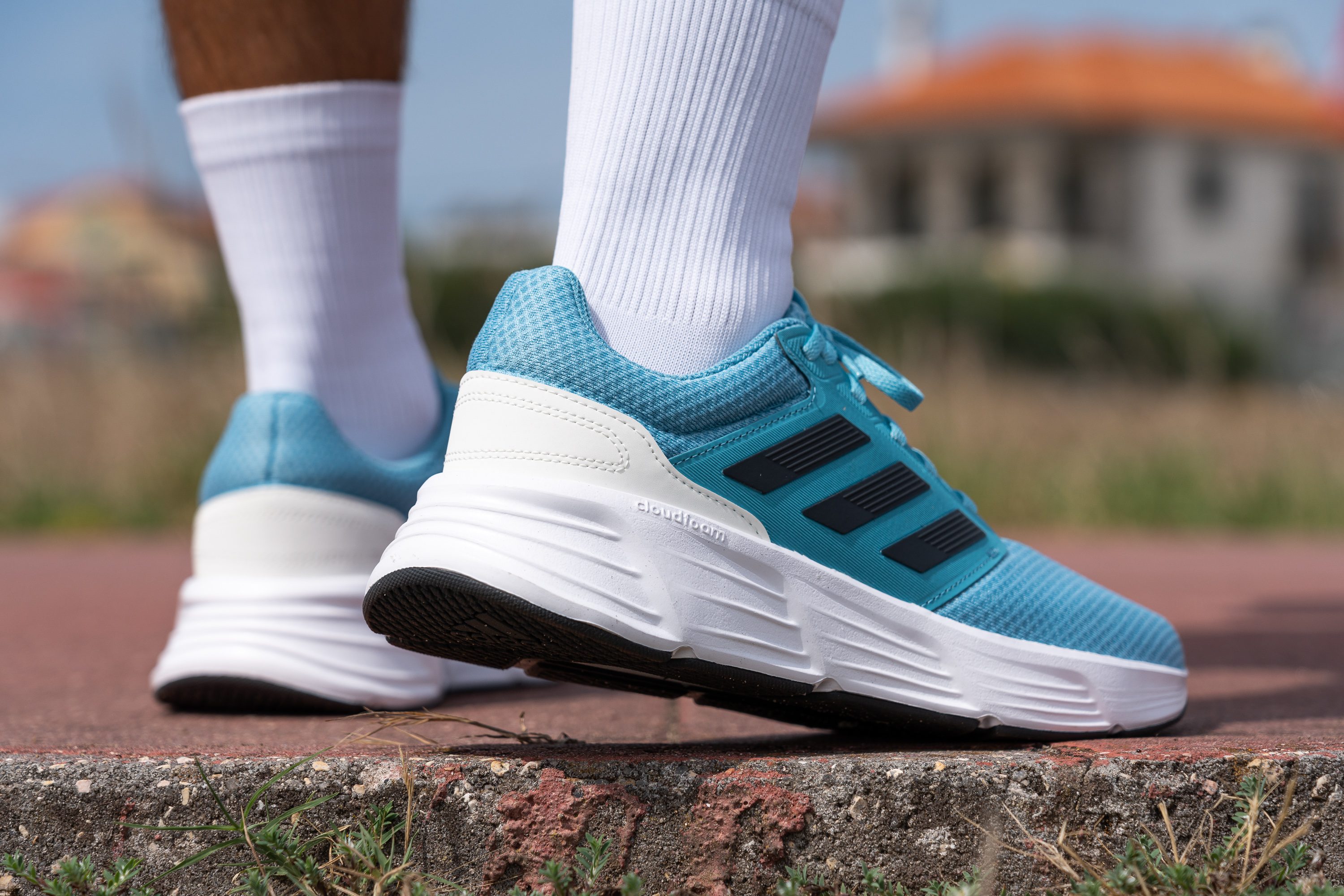
Still, it's worth mentioning that a significant reinforcement wraps around the heel, providing added stability.
| Galaxy 6 | 1 |
| Average | 2.9 |
Midsole width - forefoot
An integral component in crafting a stable running shoe is a broad landing platform. The Galaxy 6 offers a remarkable forefoot width of 120.3 mm.
This expansive platform is amazing for stability, accommodating every runner with ease, regardless of their arch support requirements.

| Galaxy 6 | 120.3 mm |
| Average | 114.4 mm |
Midsole width - heel
The heel area follows suit with a similar design. Measuring 103.7 mm, it is noticeably wider than what you'd find in most other shoes available today.
This extra width further contributes to the overall stability, although it also increases the weight of the shoe.
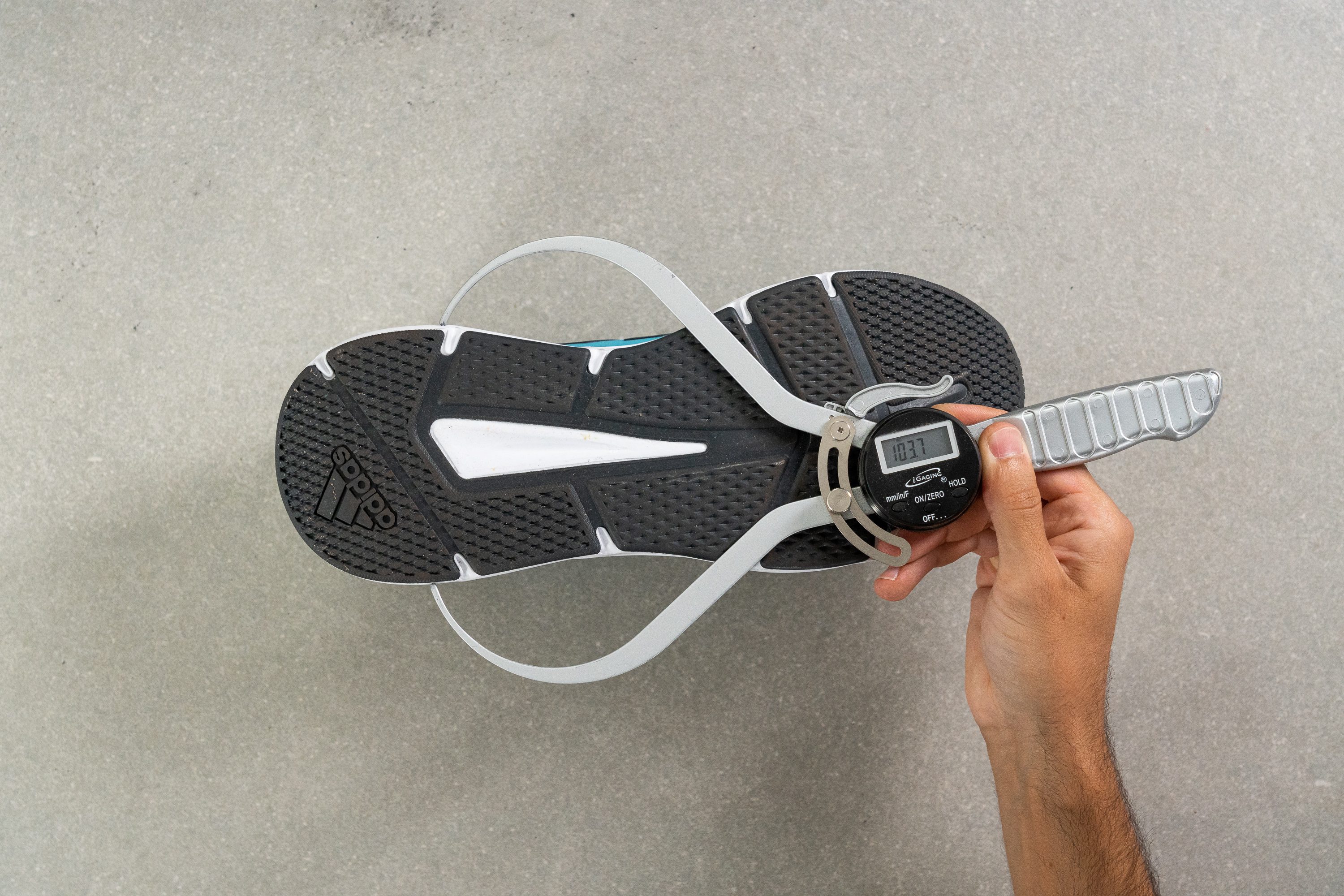
| Galaxy 6 | 103.7 mm |
| Average | 90.7 mm |
Durability
Toebox durability
After handling the upper, we weren't surprised to predict a 1/5 score for this test.
It's a common problem with some engineered mesh uppers—especially ones that are thick and cushy—they simply don't hold up well against abrasion.

| Galaxy 6 | 1 |
| Average | 2.6 |
Heel padding durability
The heel, being made of the same mesh, fares no better with another disappointing 1/5 score.
We really wish Adidas had opted for a sturdier material in this area to stand up against the wear some runners subject this part to.
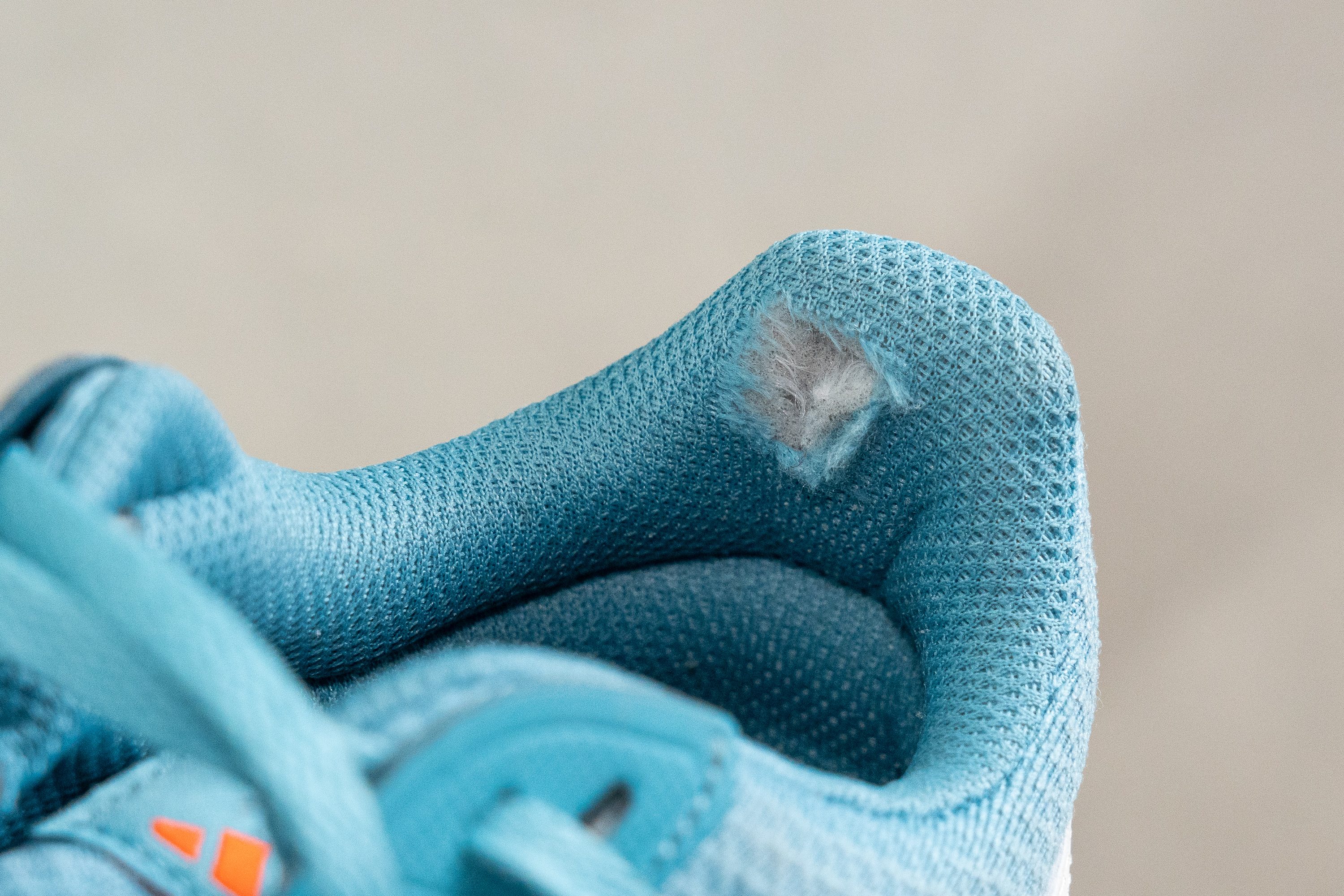
| Galaxy 6 | 1 |
| Average | 3.4 |
Outsole hardness
While most budget-friendly shoes employ incredibly hard rubber to enhance durability—considering runners don't anticipate high-level grip from a £60 shoe—Adidas chose a different path.

They've aimed for maximum grip with a softer rubber, which we recorded at just 76.4 HC.
| Galaxy 6 | 76.4 HC |
| Average | 79.2 HC |
Outsole durability
Despite the Galaxy 6 not featuring the premium Continental rubber found in the Adistar 2.0, it's admirable how well it stands up to our Dremel durability test.
It certainly proves its worth in terms of resistance, showing off an impressive resilience that we didn't expect.
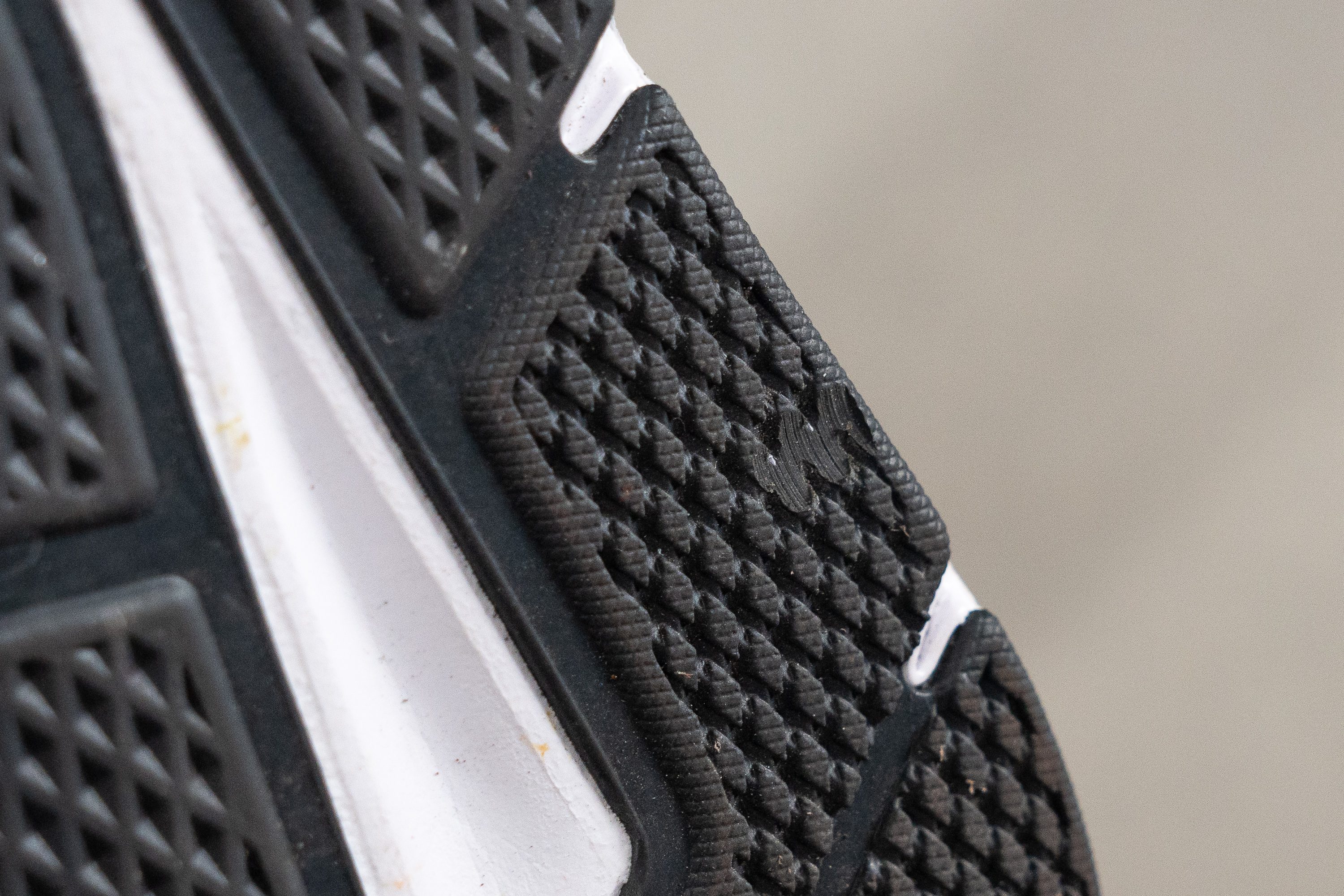
| Galaxy 6 | 1.1 mm |
| Average | 1.1 mm |
Outsole thickness
Given its thickness of 3 mm, we're confident that the outsole should not pose any durability issues.

| Galaxy 6 | 3.0 mm |
| Average | 3.2 mm |
Misc
Insole thickness
It's apparent that the designers at Adidas recognised they were working with a shoe on the heavier side. It seems they chose to trim down on some of that weight by opting for a thinner insole.
We measured this one at 3.8 mm, which is less than the average shoe.

| Galaxy 6 | 3.8 mm |
| Average | 4.5 mm |
Removable insole
A major plus of the Galaxy 6 is that you can easily remove the insole, as it's not glued at all.
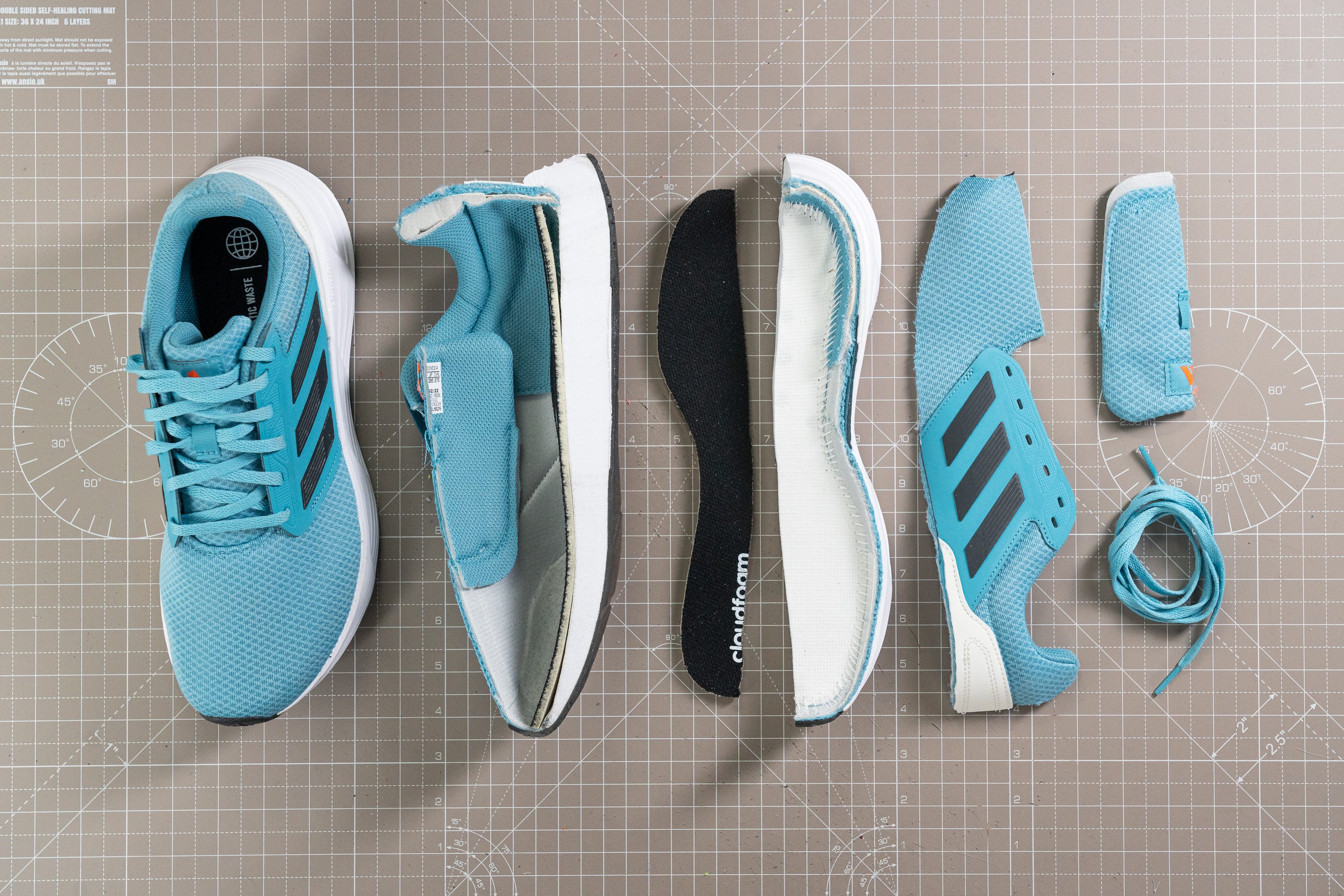
| Galaxy 6 | Yes |
Midsole softness in cold (%)
Next, we left the shoe in the freezer for 20 minutes to simulate winter conditions before taking more measurements in the lab. Regrettably, the shoe became significantly firmer, registering at 31.3 HA.
This marks a 36.6% increase, which is steeper than the average but understandable given the foam is EVA-based.
EVA is the only decent foam that can be used to produce a shoe this affordable. Unfortunately, as we proved, this type of midsole tends to become significantly firmer in cold temperatures.
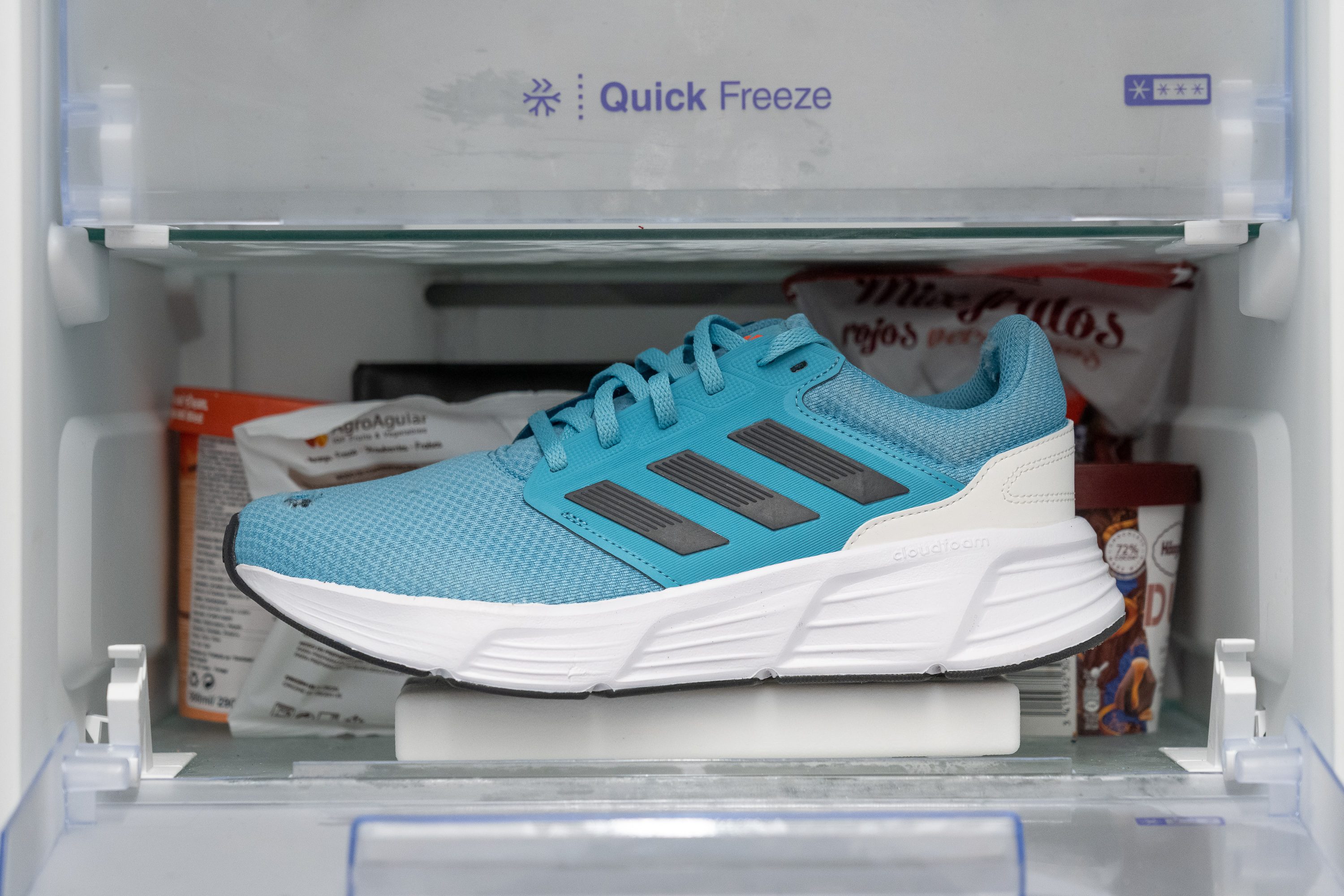
| Galaxy 6 | 37% |
| Average | 24% |
Reflective elements
While we can't expect too many features from a shoe that costs £60, the absence of reflective elements is disappointing.
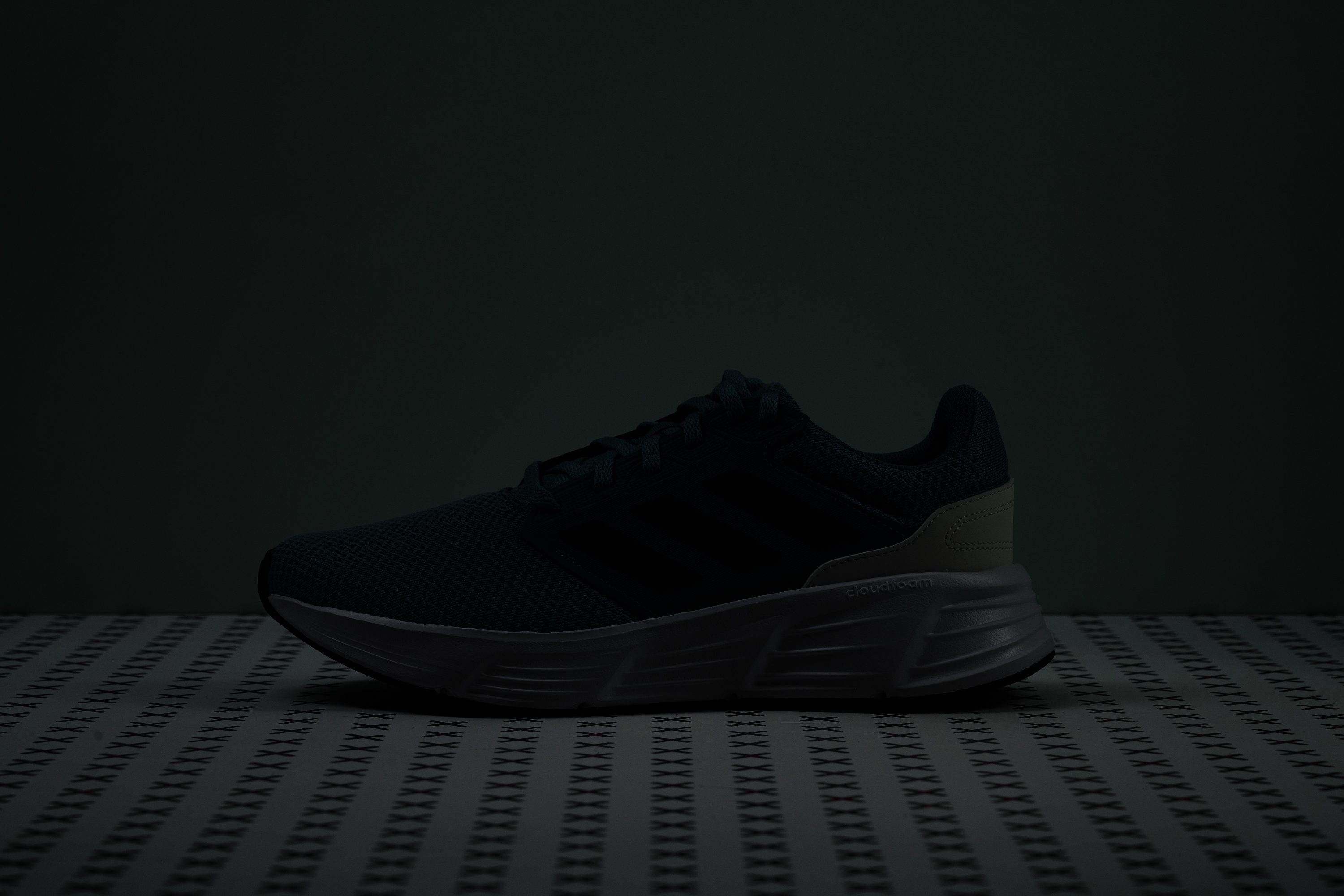
| Galaxy 6 | No |
Tongue padding
Given the outstanding weight of the Galaxy 6, we hoped for a lot of padding in the tongue. However, it's only 3.5 mm thick and leans toward the thinner side, which may impact comfort.

| Galaxy 6 | 3.5 mm |
| Average | 5.8 mm |
Tongue: gusset type
We wouldn't bet on finding a gusseted tongue in a £60 shoe and Adidas didn't surprise us this time around.
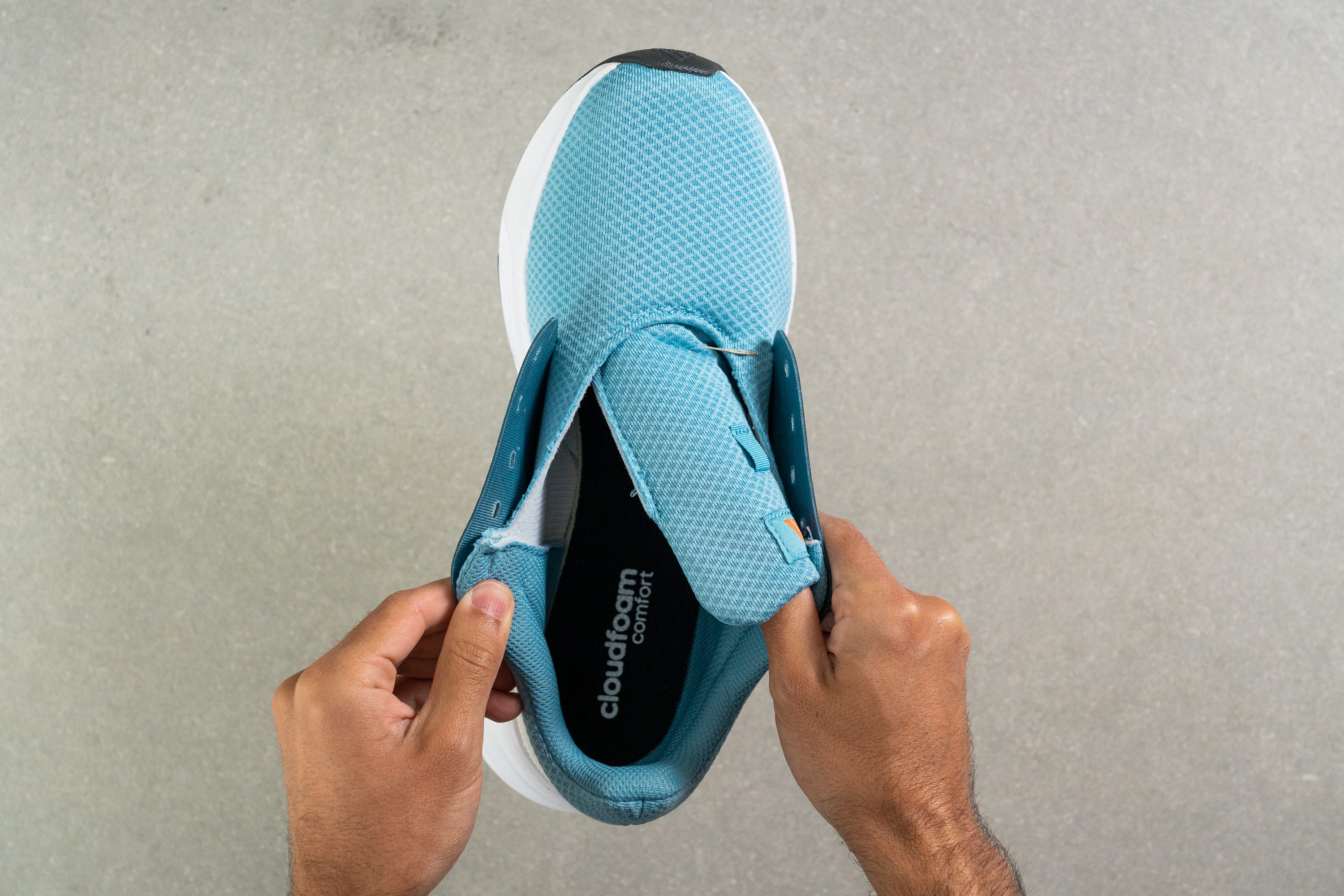
| Galaxy 6 | None |
Heel tab
There are no finger loops or pull tabs on this Adidas shoe.
| Galaxy 6 | None |

